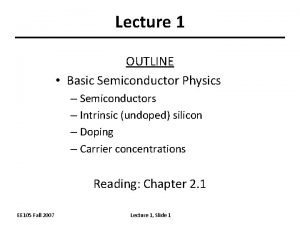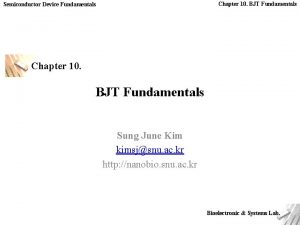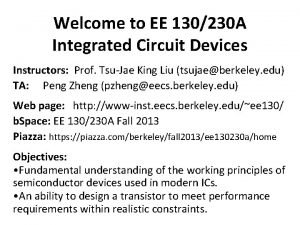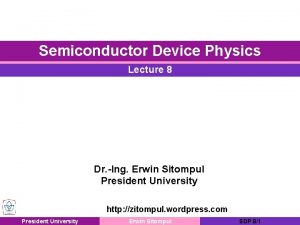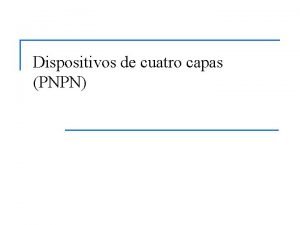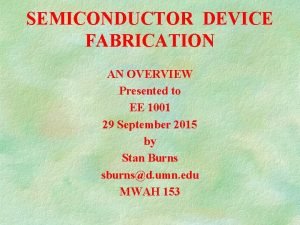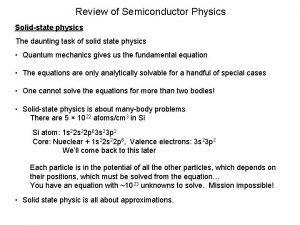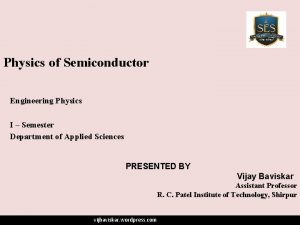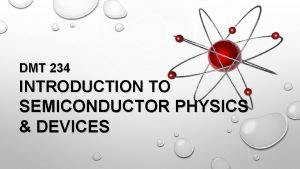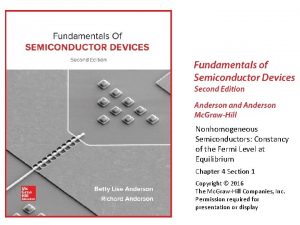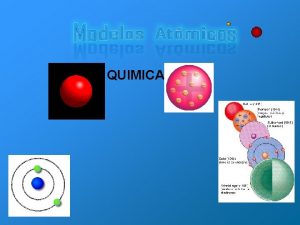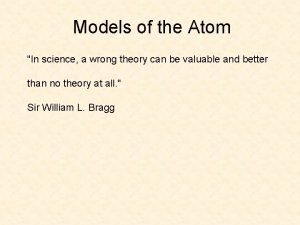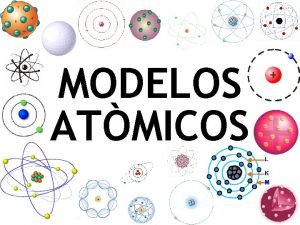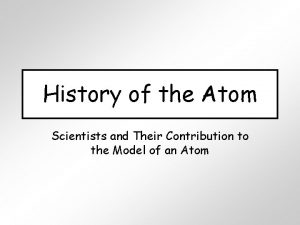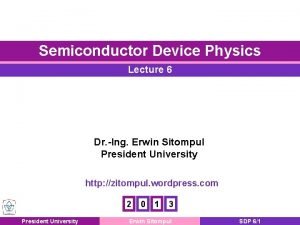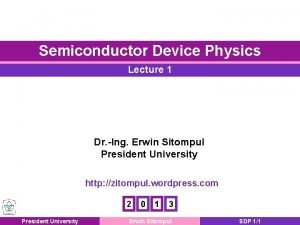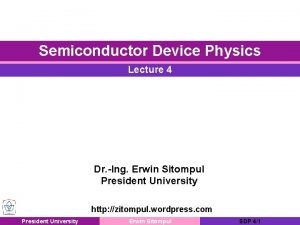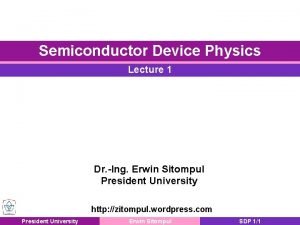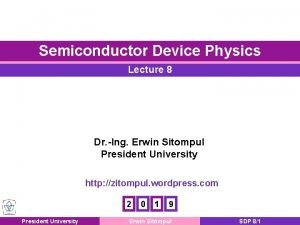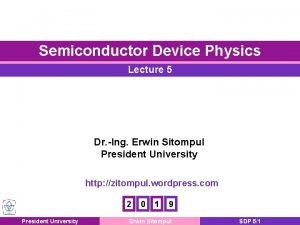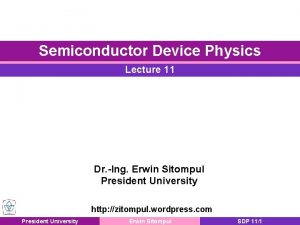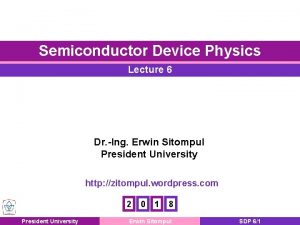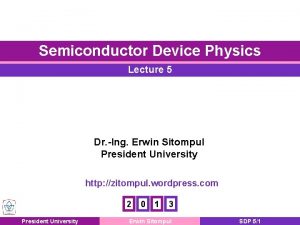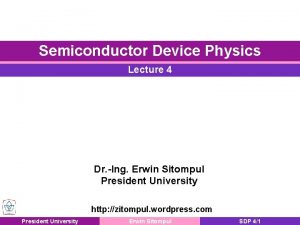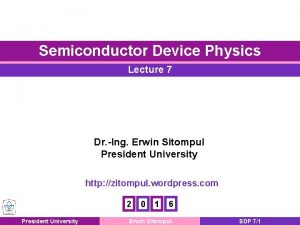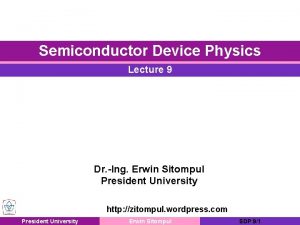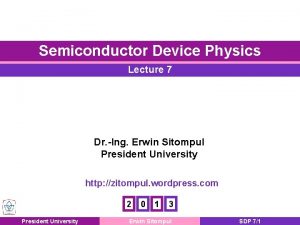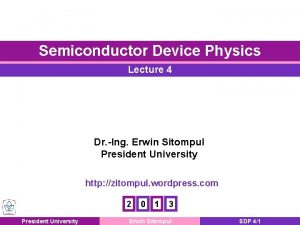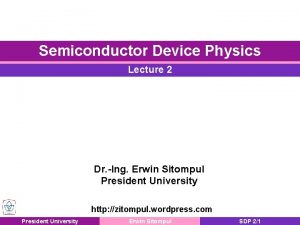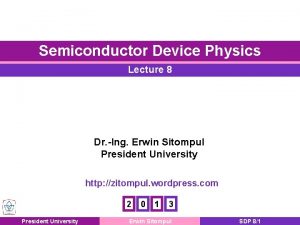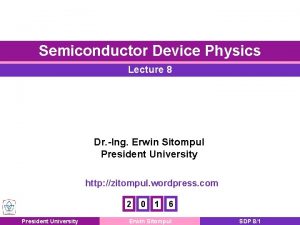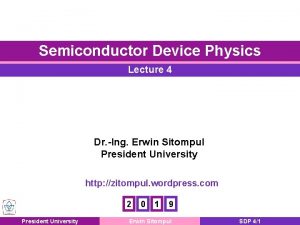Semiconductor Device Physics Lecture 4 Dr Ing Erwin

























- Slides: 25

Semiconductor Device Physics Lecture 4 Dr. -Ing. Erwin Sitompul President University http: //zitompul. wordpress. com 2 President University 0 1 6 Erwin Sitompul SDP 4/1

Chapter 3 Carrier Action Direct and Indirect Semiconductors E-k Diagrams Ec Ec Phonon Photon Ga. As, Ga. N Photon Ev Si, Ge (direct semiconductors) (indirect semiconductors) • Little change in momentum is required for recombination • Momentum is conserved by photon (light) emission President University Ev • Large change in momentum is required for recombination • Momentum is conserved by mainly phonon (vibration) emission + photon emission Erwin Sitompul SDP 4/2

Chapter 3 Carrier Action Excess Carrier Concentrations Deviation from equilibrium values Values under arbitrary conditions Equilibrium values n Positive deviation corresponds to a carrier excess, while negative deviation corresponds to a carrier deficit. n Charge neutrality condition: President University Erwin Sitompul SDP 4/3

Chapter 3 Carrier Action “Low-Level Injection” n Often, the disturbance from equilibrium is small, such that the majority carrier concentration is not affected significantly. n However, the minority carrier concentration can be significantly affected. n For an n-type material n For a p-type material n This condition is called “low-level injection condition”. n The workhorse of the diffusion in low-level injection condition is the minority carrier (which number increases significantly) while the majority carrier is practically undisturbed. President University Erwin Sitompul SDP 4/4

Chapter 3 Carrier Action Indirect Recombination Rate n Suppose excess carriers are introduced into an n-type Si sample by shining light onto it. At time t = 0, the light is turned off. How does p vary with time t > 0? n Consider the rate of hole recombination: NT : number of R–G centers/cm 3 Cp : hole capture coefficient n In the midst of relaxing back to the equilibrium condition, the hole generation rate is small and is taken to be approximately equal to its equilibrium value: President University Erwin Sitompul SDP 4/5

Chapter 3 Carrier Action Indirect Recombination Rate n The net rate of change in p is therefore: where • For holes in n-type material n Similarly, where • For electrons in p-type material President University Erwin Sitompul SDP 4/6

Chapter 3 Carrier Action Minority Carrier Lifetime n The minority carrier lifetime τ is the average time for excess minority carriers to “survive” in a sea of majority carriers. n The value of τ ranges from 1 ns to 1 ms in Si and depends on the density of metallic impurities and the density of crystalline defects. n The deep traps originated from impurity and defects capture electrons or holes to facilitate recombination and are called recombination-generation centers. President University Erwin Sitompul SDP 4/7

Chapter 3 Carrier Action Photoconductor n Photoconductivity is an optical and electrical phenomenon in which a material becomes more electrically conductive due to the absorption of electro-magnetic radiation such as visible light, ultraviolet light, infrared light, or gamma radiation. n When light is absorbed by a material like semiconductor, the number of free electrons and holes changes and raises the electrical conductivity of the semiconductor. n To cause excitation, the light that strikes the semiconductor must have enough energy to raise electrons across the band gap. President University Erwin Sitompul SDP 4/8

Chapter 3 Carrier Action Example: Photoconductor n Consider a sample of Si at 300 K doped with 1016 cm– 3 Boron, with recombination lifetime 1 μs. It is exposed continuously to light, such that electron-hole pairs are generated throughout the sample at the rate of 1020 per cm 3 per second, i. e. the generation rate GL = 1020/cm 3/s. a) What are p 0 and n 0? b) What are Δn and Δp? • Hint: In steady-state (equilibrium), generation rate equals recombination rate President University Erwin Sitompul SDP 4/9

Chapter 3 Carrier Action Example: Photoconductor n Consider a sample of Si at 300 K doped with 1016 cm– 3 Boron, with recombination lifetime 1 μs. It is exposed continuously to light, such that electron-hole pairs are generated throughout the sample at the rate of 1020 per cm 3 per second, i. e. the generation rate GL = 1020/cm 3/s. c) What are p and n? d) What are np product? • Note: The np product can be very different from ni 2 in case of perturbed/agitated semiconductor President University Erwin Sitompul SDP 4/10

Chapter 3 Carrier Action Net Recombination Rate (General Case) n For arbitrary injection levels and both carrier types in a nondegenerate semiconductor, the net rate of carrier recombination is: where • ET : energy level of R–G center President University Erwin Sitompul SDP 4/11

Chapter 3 Carrier Action Continuity Equation n Consider carrier-flux into / out of an infinitesimal volume: Area A, volume A. dx Flow of current JN(x) JN(x+dx) Flow of electron dx President University Erwin Sitompul SDP 4/12

Chapter 3 Carrier Action Continuity Equation • Taylor’s Series Expansion n The Continuity Equations President University Erwin Sitompul SDP 4/13

Chapter 3 Carrier Action Minority Carrier Diffusion Equation n The minority carrier diffusion equations are derived from the general continuity equations, and are applicable only for minority carriers. n Simplifying assumptions: n The electric field is small, such that: • For p-type material • For n-type material n Equilibrium minority carrier concentration n 0 and p 0 are independent of x (uniform doping). n Low-level injection conditions prevail. President University Erwin Sitompul SDP 4/14

Chapter 3 Carrier Action Minority Carrier Diffusion Equation n Starting with the continuity equation for electrons: n Therefore n Similarly President University Erwin Sitompul SDP 4/15

Chapter 3 Carrier Action Carrier Concentration Notation n The subscript “n” or “p” is now used to explicitly denote n-type or p-type material. n pn is the hole concentration in n-type material n np is the electron concentration in p-type material n Thus, the minority carrier diffusion equations are: • Partial Differential President University • Equation (PDE)! The so called “Heat Conduction Equation” Erwin Sitompul SDP 4/16

Chapter 3 Carrier Action Simplifications (Special Cases) n Steady state: n No diffusion current: n No thermal R–G: n No other processes: • Solutions for these common special-case diffusion equation are provided in the textbook President University Erwin Sitompul SDP 4/17

Chapter 3 Carrier Action Minority Carrier Diffusion Length n Consider the special case: n Constant minority-carrier (hole) injection at x = 0 n Steady state, no light absorption for x > 0 n The hole diffusion length LP is defined to be: Similarly, President University Erwin Sitompul SDP 4/18

Chapter 3 Carrier Action Minority Carrier Diffusion Length n The general solution to the equation is: n A and B are constants determined by boundary conditions: n Therefore, the solution is: • Physically, LP and LN represent the average distance that a minority carrier can diffuse before it recombines with a majority carrier. President University Erwin Sitompul SDP 4/19

Chapter 3 Carrier Action Example: Minority Carrier Diffusion Length n Given ND=1016 cm– 3, τp = 10– 6 s. Calculate LP. n From the plot, President University Erwin Sitompul SDP 4/20

Chapter 3 Carrier Action Quasi-Fermi Levels n Whenever Δn = Δp ≠ 0 then np ≠ ni 2 and we are at nonequilibrium conditions. n In this situation, now we would like to preserve and use the relations: n On the other hand, both equations imply np = ni 2, which does not apply anymore. n The solution is to introduce to quasi-Fermi levels FN and FP such that: • The quasi-Fermi levels is useful to describe the carrier concentrations under non-equilibrium conditions President University Erwin Sitompul SDP 4/21

Chapter 3 Carrier Action Example: Quasi-Fermi Levels n Consider a Si sample at 300 K with ND = 1017 cm– 3 and Δn = Δp = 1014 cm– 3. a) What are p and n? • The sample is an n-type b) What is the np product? President University Erwin Sitompul SDP 4/22

Chapter 3 Carrier Action Example: Quasi-Fermi Levels n Consider a Si sample at 300 K with ND = 1017 cm– 3 and Δn = Δp = 1014 cm– 3. 0. 417 e. V c) Find FN and FP? Ec FN Ei FP Ev 0. 238 e. V President University Erwin Sitompul SDP 4/23

Chapter 3 Carrier Action Homework 4 (1/2) n 1. (6. 17) A certain semiconductor sample has the following properties: DN = 25 cm 2/s τn 0 = 10– 6 s DP = 10 cm 2/s τp 0 = 10– 7 s It is a homogeneous, p-type (NA = 1017 cm– 3) material in thermal equilibrium for t ≤ 0. At t = 0, an external light source is turned on which produces excess carriers uniformly at the rate GL = 1020 cm– 3 s– 1. At t = 2× 10– 6 s, the external light source is turned off. (a) Derive the expression for the excess-electron concentration as a function of time for 0 ≤ t ≤ ∞. (b) Determine the value of the excess-electron concentration at (i) t = 0, (ii) t = 2× 10– 6 s, and (iii) t = ∞. (c) Plot the excess electron concentration as a function of time. n Problem 2 on the next slide. President University Erwin Sitompul SDP 4/24

Chapter 3 Carrier Action Homework 4 (2/2) n 2. (4. 38) Problem 3. 24 Pierret’s “Semiconductor Device Fundamentals” Replace the figure on the book with the figure below n Hint: Draw all sketches/ graph using ruler n Deadline: Monday, 10 October 2016. President University Erwin Sitompul SDP 4/25
 Input device output device storage device
Input device output device storage device Basic semiconductor physics:
Basic semiconductor physics: Power semiconductor devices lecture notes
Power semiconductor devices lecture notes Semiconductor device fundamentals
Semiconductor device fundamentals Semiconductor device fundamentals
Semiconductor device fundamentals Semiconductor device fundamentals
Semiconductor device fundamentals Dispositivos de cuatro capas
Dispositivos de cuatro capas Semiconductor device fabrication
Semiconductor device fabrication Semiconductor device
Semiconductor device Fcc wigner seitz cell
Fcc wigner seitz cell Semiconductor engineering physics
Semiconductor engineering physics Dmt 234
Dmt 234 Semiconductor and its types
Semiconductor and its types 01:640:244 lecture notes - lecture 15: plat, idah, farad
01:640:244 lecture notes - lecture 15: plat, idah, farad Classical mechanics
Classical mechanics What is a harmonic wave in physics
What is a harmonic wave in physics Phy101 lecture 1
Phy101 lecture 1 Physics 101 lecture notes pdf
Physics 101 lecture notes pdf Pdf
Pdf Atmospheric physics lecture notes
Atmospheric physics lecture notes Art as a humanistic discipline explanation
Art as a humanistic discipline explanation Modelo atomico de erwin schrödinger
Modelo atomico de erwin schrödinger Erwin schrödinger atomic theory
Erwin schrödinger atomic theory Modelo schrodinger
Modelo schrodinger Erwin schrödinger contribution to atomic theory
Erwin schrödinger contribution to atomic theory Erwin moeyaert
Erwin moeyaert

